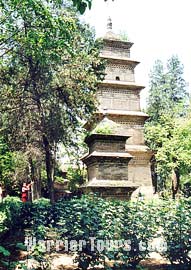- Big Wild Goose Pagoda & Tang Dynasty Palace
- Bell/Drum Tower & Daxingshan Temple
- City Wall
- Forest of Stone Steles Museum & Banpo Museum
- Great Mosque
- Huaqing Hot Springs & Xingjiao Temple
- Mausoleum of the First Qin Emperor
- Mausoleum of Western Han Emperor Liu Qi
- Terracotta Warriors
- Shaanxi History Museum
- Small Wild Goose Pagoda
- Famen Temple & Xianyang Museum
- Maoling Mausoleum & Tomb of Huo Qubing
- Mt. Huashan
- Qian Mausoleum & Zhaoling Mausoleum
Huaqing Hot Springs & Xingjiao Temple
![]() Huaqing Hot Springs
Huaqing Hot Springs
Huaqing Hot Springs (or Huaqing Palace) is famous for the romantic love story of Emperor Xuanzong (685-762) and his concubine Yang Guifei in Tang Dynasty (618-907). It also boasts top-class hot springs. Located 30 km (18.6 miles) west of Xian, the hot springs have allured many kings and emperors over the past 3,000 years. Destroyed and rebuilt several times, the existing Huaqing Palace was reconstructed in 1959, covering an area of 85,560 sq meters (21.1 acres).
The splendid scenery and abundant cultural relics of Huaqing Hot Springs is indeed a must-see for visitors.
| Admission Fee: | CNY 80 (Dec. 1 to Feb. 28 or 29) CNY 110 (Mar. 1 to Nov. 30) |
| Opening Hours: | 09:10 to 17:00 |
| Recommended Time for a Visit: |
One and a half hours |
| Bus Route: | 306, 307 |

![]() Xingjiao Temple
Xingjiao Temple
Located 20 km south of Xian City, beside the Shaoling Plateau, the Temple of Flourishing Teaching (Xingjiao Temple is one of the most important Chinese Buddhist temples because of the Xuanzang Pagoda inside. Xuanzang, the famous hierarch in Chinese history, traveled to India along the ancient Silk Road and learned Buddhism there. When he came back to Chang'an (now it is called Xian), he translated many sutras which he brought back to the Da Ci'en Temple, Yuhua Palace and Hongfu Temple. Xuanzang passed away in 664 and was buried in the White Deer Plateau, to the east of Xian City. In 669, he was moved to the current location situated in a pagoda. Later, the Temple of Flourishing Teaching was built on the site.
When you walk into the entrance, you see the Bell Tower and Drum Tower on each side of the road. Inside the Mahavira Hall (Da Xiong Bao Dian), a 3.2-meter (10.5 ft) high sculpture of Sakyamuni sits in the middle. A giant statue of Lying Buddha is situated in the back hall. The Lying Buddha, which is 9 meters (29.6 ft) long, was carved by camphor wood. Xuanzang Pagoda is situated in the West Courtyard. The five-storey brick pagoda is about 21 meters (68.9 ft) high enshrining the sculpture of Xuanzang on the first floor. A stele recording the life of Xuanzang is also housed in the first floor. Pagodas of two disciples of Xuanzang, Yuance and Kuiji, are also situated in the yard. The East Courtyard is the Sutra-Keeping Hall. Different versions of ancient sutras are well preserved here. The Palm-leaf Sutra, which was brought back by Xuanzang, is the most precious one among all of the treasures.
Although the Temple of Flourishing Teaching is less popular among visitors, it's still an attractive destination for pilgrims and those who adore Xuanzang.
| Admission Fee: | CNY 10 |

